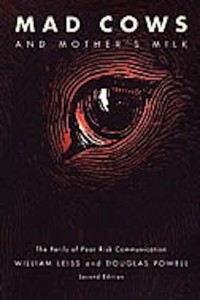As the co-author of Mad Cows and Mother’s Milk (1997) I couldn’t let this slide.
 A lab accident in 2010 likely led to a woman’s untimely death nearly a decade later, according to doctors in France. In a recent case study, they describe how a woman in her early 30s developed a universally fatal brain disorder years after she had pierced her skin with equipment used to handle infectious rogue proteins called prions.
A lab accident in 2010 likely led to a woman’s untimely death nearly a decade later, according to doctors in France. In a recent case study, they describe how a woman in her early 30s developed a universally fatal brain disorder years after she had pierced her skin with equipment used to handle infectious rogue proteins called prions.
Prions are a type of protein that exist naturally in our brains. Ordinarily, they’re thought to be harmless, though their exact function remains a mystery. But rarely, they can transform into a misfolded version that compels normal prions to change shape, too. Over years or even decades, this cascade of misfolded prions destroys the brain from the inside out, leaving behind signature sponge-like holes under a microscope. Because of these holes, prion diseases are also medically known as transmissible spongiform encephalopathies.
Prion diseases often happen with no clear rhyme or reason — native prions just seem to spontaneously pull a heel turn. Other times, a person’s inherited genetics are to blame. But what makes prions even scarier is that they can be also infectious, spreading from one person to another or across different species of animals.
In the 1980s and 1990s, scientists noticed outbreaks of cows that were developing their own prion disease, which became popularly known as mad cow disease. Years later, we began seeing people develop a never-before-seen sort of prion disease, which was eventually traced to them eating contaminated beef (meanwhile, the cows were being infected from eating animal feed that contained brain matter from other infected cows and possibly sheep). Medically, this infectious type of prion disease became known as variant-Creutzfeldt-Jakob disease (vCJD), to distinguish it from the classic version that’s the most common but still very rare prion disease in humans.
The young woman had been a lab technician in a research facility studying prions in 2010, according to a case study published in the New England Journal of Medicine this month. One day in May, she was using a pair of curved forceps to handle frozen, prion-infected brain samples taken from mice genetically engineered to develop human prions, when the forceps slipped and stabbed into her thumb. Though she was wearing two pairs of protective gloves, the sharp ends pierced her skin and drew blood. She was only 24 at the time.
About seven and a half years later, in November 2017, she began experiencing a burning pain down her right shoulder and neck. Her condition worsened over the next year, to the point of memory impairment, visual hallucinations, and muscle stiffness along her right side by January 2019. Eventually, 19 months after the onset of symptoms, she died. Tests before her death strongly suggested she had vCJD, which was confirmed post-mortem.
It’s possible that the woman might have caught vCJD through eating tainted beef made before sharp shifts in the meat processing industry came along that seemed to end the threat of mad cow disease in the 1990s. But that would be very unlikely, according to the authors, because vCJD isn’t thought to take longer than a decade to show up after exposure in people with the woman’s genetic makeup. Nearly all known cases of vCJD have been in people who share a specific but relatively common genetic variation of their prion gene, called MM, which the women also carried. But the timing does work out if you assume she caught vCJD through the lab accident.
Prion diseases remain incredibly rare, and even in cases where they are infectious, genetics seem to strongly influence the risk of actually becoming sick (only a few hundred cases of vCJD have ever been reported worldwide). But this isn’t the first time that a case of vCJD has been linked to exposure in a lab, according to the authors, suggesting that more could be done to keep scientists and technicians safe during the valuable work they do to understand these utterly mysterious things. Prions are notoriously very hard to “kill” using traditional decontamination methods, which provides an added source of concern for medical procedures involving the brain.



